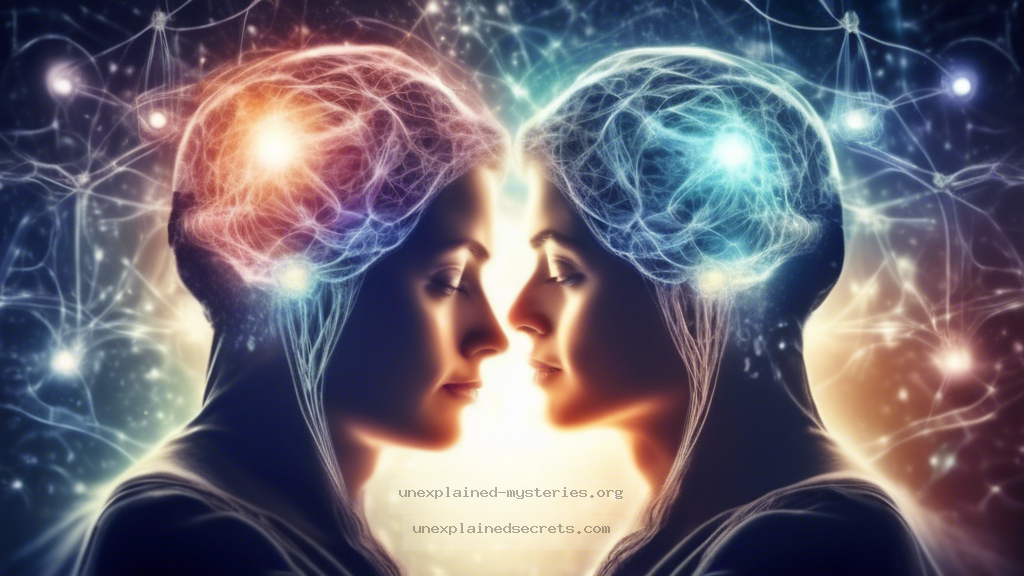Can Scientific Evidence of Telepathy Challenge Our Understanding of Human Consciousness?
Can Scientific Evidence of Telepathy Challenge Our Understanding of Human Consciousness?
The idea of telepathy, or the ability to communicate thoughts and feelings without the use of the traditional five senses, has long captured the imagination of both the scientific community and the general public. With numerous studies conducted over the decades, the question of whether telepathy can be proven scientifically remains a hot topic. This post explores a range of compelling research and documented cases concerning telepathy, shedding light on how these findings might challenge or reaffirm our understanding of human consciousness.
Historical Context of Telepathy Research
The concept of telepathy has roots that extend back to ancient civilizations, where it was often intertwined with spirituality and mysticism. However, it wasn’t until the late 19th and early 20th centuries that telepathy began to attract serious scientific inquiry. The Society for Psychical Research, established in 1882, aimed to investigate paranormal phenomena, including telepathy. Early experiments often involved “thought transference” between individuals, particularly among twins or close relatives, leading to a wealth of anecdotal evidence but little empirical validation.
Throughout the 20th century, notable figures like J.B. Rhine at Duke University began to systematically study telepathy through controlled experiments. Rhine’s work, particularly with Zener cards, sought to quantify psychic phenomena, but results were often met with skepticism. The lack of replicable results led to a decline in serious scientific exploration of telepathy, pushing it back into the realm of pseudoscience for many. Despite this, interest has recently resurged, with new technologies and methodologies allowing for more robust investigations.
Core Concepts and Theories of Telepathy
Understanding telepathy requires delving into various theories that attempt to explain how this phenomenon may occur. One prominent theory is that of “non-local consciousness,” suggesting that consciousness is not confined to the brain but can exist in a broader field. This notion aligns with quantum theories of consciousness, which posit that the brain operates in a manner similar to quantum mechanics, potentially allowing for instantaneous communication across distances.
Another theory suggests that telepathy operates on the basis of bioenergetic fields, where individuals emit and receive subtle energy signatures. This aligns with concepts from Eastern philosophies, such as Qi or Prana, which describe life energy flowing through living beings. While these theories remain controversial, they provide a framework for exploring the potential mechanisms behind telepathic phenomena.
Scientific Evidence Supporting Telepathy
While telepathy remains largely unproven in the scientific community, there have been several intriguing studies that suggest its possibility. One of the most compelling pieces of evidence comes from research conducted by the Princeton Engineering Anomalies Research (PEAR) lab, which studied random number generators (RNGs) and their correlation with the mental focus of participants. The results indicated statistically significant deviations from randomness when participants attempted to influence the RNGs through thought alone.
Another significant study involved pairs of individuals attempting to send and receive images telepathically. In one experiment, participants were placed in separate rooms, with one group shown a series of images while the other was asked to “receive” the images through telepathy. The results showed a higher-than-chance success rate in accurately identifying the images, suggesting a possible telepathic connection.
| Study | Methodology | Key Findings |
|---|---|---|
| PEAR Lab (1979-2007) | Random number generator tests | Statistically significant deviations from randomness were observed. |
| Telepathy Image Experiment | Participants attempted to send/receive images | Higher-than-chance success rates were noted. |
Documented Cases of Telepathy
Throughout history, there have been numerous documented cases that proponents of telepathy often cite as evidence. One of the most famous cases involves the identical twins, Jim and Joe, who reportedly shared a deep mental connection. They often claimed to experience each other’s thoughts and emotions, even when separated by long distances. Such anecdotal cases fuel the ongoing debate about the nature of telepathy and its potential scientific validity.
Another notable account involves the story of a soldier and his wife during World War II. The soldier experienced a sudden sense of dread when his wife was in danger, despite being thousands of miles away. After the war, he learned that his wife had been in a life-threatening situation at the exact moment he felt the intense fear. Such cases raise profound questions about the boundaries of human consciousness and emotional connectivity.
Alternative Perspectives on Telepathy
While many researchers and enthusiasts advocate for the potential of telepathy, skepticism remains prevalent within the scientific community. Critics argue that the evidence presented is often anecdotal and lacks the rigorous testing required to validate such extraordinary claims. The scientific method emphasizes repeatability and controlled conditions, and many telepathy studies fall short of these criteria.
Moreover, psychological explanations, such as the ideomotor effect or confirmation bias, may account for perceived telepathic experiences. The ideomotor effect refers to the influence of subconscious actions that lead individuals to believe they are receiving telepathic messages. In this context, it becomes essential to differentiate between genuine telepathic experiences and those that may arise from psychological phenomena.
Common Misconceptions About Telepathy
As interest in telepathy grows, so do the misconceptions surrounding it. Many people believe that telepathy allows for precise communication, akin to verbal language. However, most accounts suggest that telepathy operates on a more intuitive level, often conveying emotions or vague thoughts rather than explicit messages.
Another common misconception is that telepathy is a rare ability possessed only by a select few. In reality, many proponents suggest that telepathy exists within everyone to varying degrees. The key may lie in enhancing one’s intuitive abilities through practices such as meditation, mindfulness, and emotional attunement with others. This perspective aligns with the notion that everyone has the potential to develop their telepathic skills.
Best Practices for Investigating Telepathy
For those interested in exploring telepathy, it is crucial to approach the investigation methodically and with an open mind. Here are some best practices for conducting research in this area:
- Controlled Environment: Conduct experiments in a controlled setting to minimize external variables that could influence results.
- Document Experiences: Keep a detailed journal of any telepathic experiences, noting the context, emotions, and outcomes.
- Peer Collaboration: Work with others interested in telepathy to share insights, methodologies, and findings.
- Stay Skeptical: Maintain a critical mindset, acknowledging the potential for psychological explanations for experiences.
- Utilize Technology: Consider using technology, such as EEG or fMRI, to explore brain activity during telepathic attempts.
Future Developments and Ongoing Research
The future of telepathy research looks promising, particularly with advancements in neuroscience and technology. New methods of brain imaging and biofeedback may allow researchers to observe brain patterns associated with telepathy, providing more empirical evidence. Additionally, interdisciplinary collaborations between neuroscientists, psychologists, and parapsychologists could lead to innovative approaches in understanding consciousness and telepathic phenomena.
Moreover, as societal acceptance of alternative forms of consciousness continues to grow, more funding and resources may be allocated toward this field of study. This shift could pave the way for rigorous scientific inquiry into telepathy, helping to demystify this fascinating aspect of human experience.
Conclusion
In conclusion, the question of whether scientific evidence of telepathy can challenge our understanding of human consciousness is both complex and compelling. While historical skepticism has clouded telepathy research, recent studies and documented cases provide tantalizing evidence that warrants further exploration. The intersection of science, consciousness, and human connection continues to evolve, and as our understanding deepens, we may one day unlock the mysteries of telepathy and its implications for human experience.
As researchers delve deeper into the realms of consciousness and the potential for telepathic communication, society stands at the threshold of a new understanding of what it means to connect with one another—beyond the limits of our physical senses. Whether telepathy becomes an accepted aspect of our understanding of consciousness remains to be seen, but the journey to uncover its truths promises to be as intriguing as the phenomenon itself. 🌌
Other Articles
Recent Posts
- What Happened to Flight MH370? The Conspiracy Theories That Still Haunt Us
- What Secrets Lurk Within the Walls of the Infamous Trans-Allegheny Lunatic Asylum?
- What Evidence Supports the Existence of Bigfoot in the Pacific Northwest?
- What Happened to the Indus Valley Civilization? Unraveling the Mysteries of Ancient Urban Life
- Can Telepathy Be Scientifically Proven Through Laboratory Evidence?







